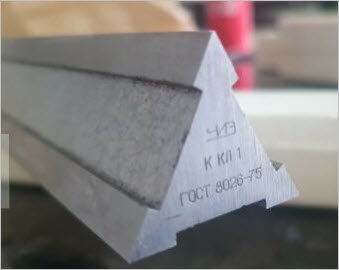-
Welcome back Guest! Did you know you can mentor other members here at H-M? If not, please check out our Relaunch of Hobby Machinist Mentoring Program!
You are using an out of date browser. It may not display this or other websites correctly.
You should upgrade or use an alternative browser.
You should upgrade or use an alternative browser.
Three sided machinist straight edge
- Thread starter petertha
- Start date
- Joined
- May 27, 2016
- Messages
- 3,469
My first thought is that is perhaps useful for spotting 60° dovetails.
- Joined
- Nov 26, 2017
- Messages
- 1,516
At first glance;
1) I would imagine that it is very rigid and will hold a true line.
2) It is probably heavy so it is less likely to move.
3) It looks like it is cast iron which means it is very stable and not as subject to heat alterations
4) It could serve as a level much like the cast iron camel back straight edges
An issue is that it is pretty short and I don't get the handle.
1) I would imagine that it is very rigid and will hold a true line.
2) It is probably heavy so it is less likely to move.
3) It looks like it is cast iron which means it is very stable and not as subject to heat alterations
4) It could serve as a level much like the cast iron camel back straight edges
An issue is that it is pretty short and I don't get the handle.
- Joined
- Mar 26, 2018
- Messages
- 2,724
Looks a lot like the old architectural straight edges used in drafting. I can't tell from the picture how large the cross section is, but they were usually about 1/2" "diameter" and had different graduations on each side.
I don't think you'd have a great dovetail spotting experience since the middle of each side is relieved.
I don't think you'd have a great dovetail spotting experience since the middle of each side is relieved.
- Joined
- Apr 29, 2019
- Messages
- 2,059
That is a toolmakers straight edge, it is used for checking things like the bed of a lathe. A lathe could be completely flat relative to the floor, but the Vs could be ground in a circle.
They also come in 4 sided to also check squareness.
They also come in 4 sided to also check squareness.
- Joined
- Nov 12, 2017
- Messages
- 391
Two distinct forms are flat edged, or knife edged.
Straight edges are used many ways. Most center around detecting high or low spots, aligning 2 or more individual components, bridging unconnected areas to support a bubble level or run indicators, and scribing long lines, for example. A rough casting could be "trammed" dependably with a straight edge, properly supported; IF the mounting surface [surface plate, mill, grinder...] is also level.
Flat edged commonly are wide enough to support themselves upright, sufficient width for rigidity. A reliable test would park the edge on equal thickness feeler stock at Airy/ Bessel points { https://www.engineeringnotes.org/metrology/airy-points-and-bessel-points/ }. A third feeler of equal or increment thinner/ thicker size would detect corresponding high or low spots.
Knife-edges are usually hand held in direct contact with clean surface in question, toward illumination that highlights discrepancies, including poor surface finish. A typical test includes along length, width and across corners.
A cylindrical square is very similar, by nature of the shape making minimal linear contact.
Straight edges are used many ways. Most center around detecting high or low spots, aligning 2 or more individual components, bridging unconnected areas to support a bubble level or run indicators, and scribing long lines, for example. A rough casting could be "trammed" dependably with a straight edge, properly supported; IF the mounting surface [surface plate, mill, grinder...] is also level.
Flat edged commonly are wide enough to support themselves upright, sufficient width for rigidity. A reliable test would park the edge on equal thickness feeler stock at Airy/ Bessel points { https://www.engineeringnotes.org/metrology/airy-points-and-bessel-points/ }. A third feeler of equal or increment thinner/ thicker size would detect corresponding high or low spots.
Knife-edges are usually hand held in direct contact with clean surface in question, toward illumination that highlights discrepancies, including poor surface finish. A typical test includes along length, width and across corners.
A cylindrical square is very similar, by nature of the shape making minimal linear contact.
- Joined
- Apr 8, 2021
- Messages
- 73
Triangles do not deflect very much, I bought one of the Russian ones, its hard and straight, not for spotting but checking


